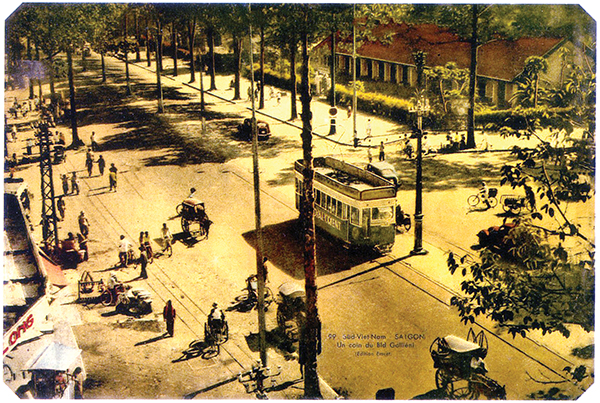A Vietnamese journalist has recently released the second volume of his book on Saigon (the former name of Ho Chi Minh City) to wear his adoration for the city on his sleeve.
>> An audio version of the story is available here
Journalist/writer Pham Cong Luan, 54, introduced the second volume of his book titled “Sai Gon – Chuyen Doi Cua Pho” (Saigon – Life Stories of a City) on Friday last week.
The book offers a rich, insightful kaleidoscope of the 317-year-old city by intertwining the author’s personal accounts with his overwhelming emotions and rare photos which he collects from insiders and historical witnesses.
The resounding success of his first volume has put Luan among the few writers on Saigon.

Vietnamese journalist Pham Cong Luan's first volume of his book on Saigon titled "Sai Gon – Chuyen Doi Cua Pho" (Saigon – Life Stories of a City)
The first volume, which was debuted in January 2014 and had a reprint only 10 days after the release, features 36 writings about Saigonese, the cityscape, and a number of photos that have never been published never.
“Though I was born and grew up in Saigon, like most people, my knowledge of the large, culturally rich city was quite fragmentary until I delved into it to write the two volumes,” Luan told Tuoi Tre (Youth) newspaper following the release of his second volume.
“However, there’re certain issues which I cannot fully address for both subjective and objective reasons.”
One of the objective reasons is that research on the three-century-old city’s lifestyle and culture has yet to be comprehensive or systematic.
Most of the systematic old-time literature on the city is written in French, which poses a major hurdle to those who are not proficient in the language, he explained.
 A Givral Cafe store is seen at the former Bonard and Catinat intersection (now Le Loi and Dong Khoi Streets in downtown Ho Chi Minh City) in the early 1950s in this file photo, which features an outing of a family in the foreground.
A Givral Cafe store is seen at the former Bonard and Catinat intersection (now Le Loi and Dong Khoi Streets in downtown Ho Chi Minh City) in the early 1950s in this file photo, which features an outing of a family in the foreground.
“My new volume just offers a subjective insight into Saigon during its good old days and leverage rare materials alongside interviews with living witnesses and a wide range of photos,” the author noted.
The volume also provides his personal accounts, which vividly depict the lifestyle back then of his own, family members, and everyone around.
In the second volume, which he said is less sentimental and personal than the first, Luan also incorporates intriguing details known only to the insiders.
“In 1972, when I was 11, my father, who was working at a stall in Ben Thanh Market, told us that there were plans to tear down the market to make room for a modern, multi-floor facility. After a while, he said the plan was scrapped due to vehement public objection, so the market has persisted as one of the city’s icons until now,” he revealed.

The cover of the second volume of a book on Saigon titled "Sai Gon – Chuyen Doi Cua Pho" (Saigon – Life Stories of a City) authored by Vietnamese journalist Pham Cong Luan
n writing his second volume, Luan met and interviewed an artist who performed in Saigon 60 years ago.
The artist supplied him with rare materials on Saigon’s wartime tourist activities and allowed him to publish his unseen photos of late revered composer Trinh Cong Son, which were taken when Son was a 23-year-old teacher.
Luan’s book also ingeniously captures Saigon’s first-ever supermarket, which was well-equipped just as its successors nowadays.
Another highlight is the portraits of male actors in Saigon some half a century ago.

Late revered Vietnamese composer Trinh Cong Son is shown playing the guitar when he was 23 years old.
A number of young people have been engaged in cherishing memories of old-time Saigon by composing pictorial books which feature rarely seen old photos, postcards and paintings, as well as sharing writings on the city on social networks, Luan observed.
“These efforts to retain and preserve urban memories should be heartily embraced and encouraged. A city with no memories is just like a person who has no recollection of their birthplace and how they grew up. A city sans memories would thus have no value to pass on to future generations,” the author concluded.
Born in 1961 in Saigon, Pham Cong Luan currently works at the Ho Chi Minh City office of Sinh Vien Viet Nam-Hoa Hoc Tro (Vietnamese Students-Pupil Flowers) magazine.
Apart from his two-volume book “Sai Gon – Chuyen Doi Cua Pho,” he is also the author of some other books popular with young local readers.

Vietnamese journalist Pham Cong Luan. Photo courtesy of Pham Cong Luan
Like us on Facebook or follow us on Twitter to get the latest news about Vietnam!




















































